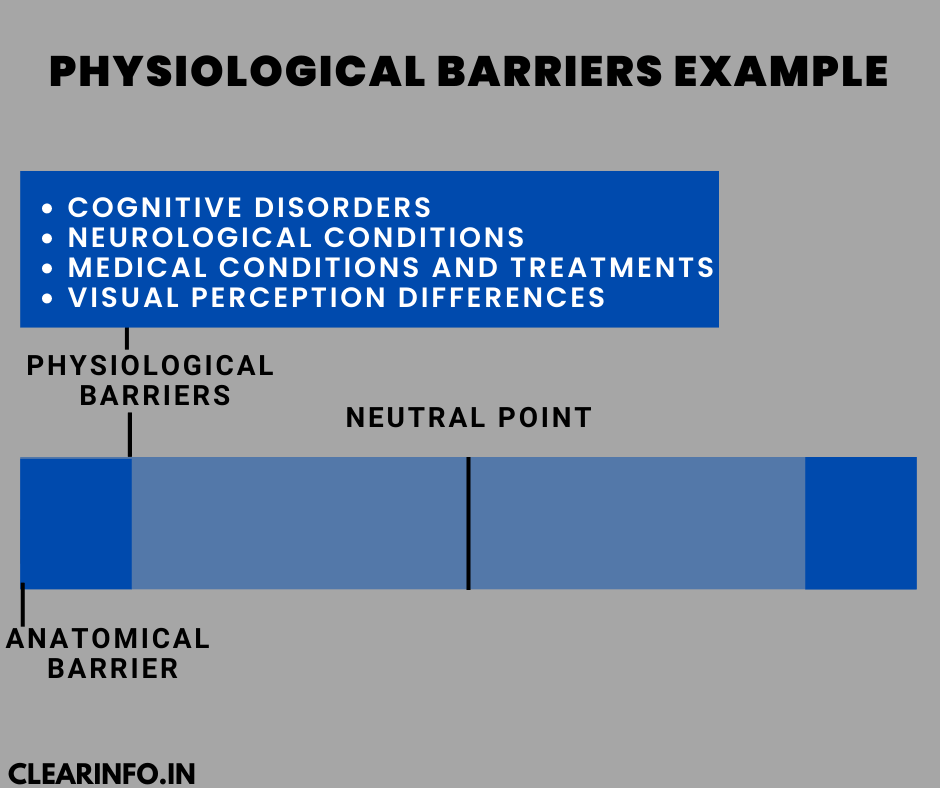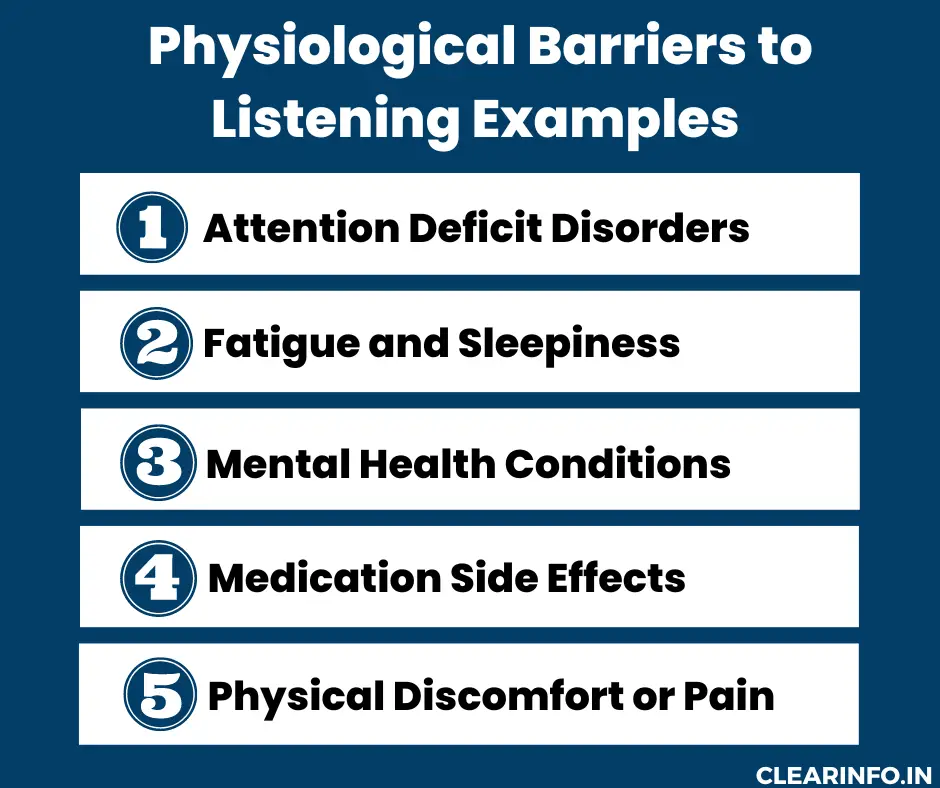Physiological barriers to communication definition
“Barriers to communication can be physiological, where issues with hearing, seeing, or speaking disrupt the smooth exchange of information and ideas between individuals or groups.”
(Source: Essentials of Organizational Behavior: An Evidence-Based Approach, by Terri A. Scandura)
What are Physiological barriers to communication?
Physiological barriers to communication refer to the physical conditions or limitations that can impact the effective exchange of information between individuals. These barriers are rooted in various physiological factors, such as sensory impairments and neurological conditions, which directly affect a person’s ability to send or receive messages.
The most common physiological barriers include vision impairment, hearing impairment, language disorders, and speech impairments. Additionally, physiological barriers can also affect both verbal and non-verbal communication, making it challenging for individuals to convey or understand information accurately.
Therefore, when a person faces physiological barriers, their ability to send or receive information may be compromised, leading to miscommunication or difficulty in expressing themselves clearly.
Physiological barriers to communication examples
Most common physiological barriers to communication along with examples:
1/ Hearing Impairments:
- Partial or complete deafness.
- Difficulty distinguishing sounds or speech.
- Inability to hear soft or high-pitched sounds.
2/ Speech Disorders:
- Stuttering or stammering.
- Articulation difficulties.
- Apraxia, where the coordination of speech muscles is impaired.
3/ Visual Impairments:
- Blindness or low vision.
- Difficulty reading written text or visual materials.
- Challenges interpreting facial expressions or body language.
4/ Physical Disabilities:
- Limited mobility affects gestures or body language.
- Inability to use hand movements or facial expressions to convey messages.
- Dependence on assistive devices that may affect communication dynamics.
5/ Visual Perception Differences:
- Difficulty recognizing or interpreting visual cues or symbols.
- Sensory processing disorders affect how visual information is processed.
- Challenges with eye contact or visual tracking during communication.
Physiological barriers example
Our body consists of various types of barriers, which can be categorized as follows:
- Neutral Points (Point of maximal ease)
- Physiological Barriers (Active motion)
- Anatomical Barriers (Passive motion)
These barriers play a role in the movement and functioning of our bodies.

Physiological barriers to listening examples

What are the types of physiological barriers to communication?
1/ Visual impairments:
Visual impairments refer to conditions that affect an individual’s ability to see or interpret visual information accurately. According to WHO approximately 2.2 billion individuals worldwide experience either near or distance vision impairment. Thus, people with visual impairments may have a partial or complete loss of vision, making it challenging for them to perceive facial expressions, body language, and other non-verbal cues during communication.
Visual impairments can prevent effective communication in several ways. Here are a few key points to consider:
- Non-verbal cues and facial expressions: Visual cues play a crucial role in communication, as they provide additional meaning and context to verbal messages. People with visual impairments may miss out on important non-verbal cues, such as facial expressions, gestures, and body language.
- Alternative communication methods: Individuals with visual impairments often rely on alternative communication methods to overcome barriers. These methods include braille, a system of raised dots that can be read by touch, and assistive technologies such as screen readers and magnifiers.
It is important to note that not all individuals with visual impairments use the same communication methods. The specific needs and preferences of each person should be taken into consideration for effective communication.
2/ Hearing impairments:
Hearing impairments refer to conditions that affect an individual’s ability to hear sounds and speak clearly. These conditions can range from mild hearing loss to profound deafness.
Presently, over 1.5 billion individuals, accounting for nearly 20% of the global population, live with some form of hearing loss, with 430 million among them facing disabling hearing loss. Thus, individuals with hearing impairments face unique challenges in communication, particularly when it involves spoken language.
Key points to consider regarding hearing impairments and communication:
- Difficulty in understanding spoken language: People with hearing impairments may have difficulty understanding spoken language, especially in environments with background noise or when the speaker’s voice is unclear. This can lead to misinterpretations of messages.
- Sign language and lip-reading: Sign language serves as the primary mode of communication for numerous individuals who experience hearing impairments. It includes a combination of hand gestures, facial expressions, and body movements to effectively convey meaning. Furthermore, lip-reading is also commonly used, where individuals rely on observing the movements of a speaker’s lips to understand what is being said.
It is important to remember that not all individuals with hearing impairments communicate in the same way. Some may use a combination of strategies, while others may rely on specific methods based on their preferences and abilities.
3/ Speech impairments:
Speech impairments involve difficulties in articulating or producing sounds, affecting an individual’s ability to express themselves verbally. These impairments can include speech disorders such as stuttering, lisping, or apraxia, which may make speech unclear or difficult to understand.
Individuals with speech impairments may find it challenging to convey their thoughts, ideas, or emotions effectively, leading to frustration. They may require additional time or assistance to express themselves, and listeners need to be patient, attentive, and supportive.
When communicating with someone who has a speech impairment, it is important to maintain eye contact, listen attentively, and avoid interrupting or finishing their sentences. Providing a supportive and non-judgmental environment can help individuals with speech impairments feel more comfortable and confident in expressing themselves.
4/ Mobility impairments:
Mobility impairments refer to physical disabilities that affect an individual’s ability to move or control their body movements. These disabilities can result from conditions such as paralysis, muscular dystrophy, or limb loss, among others. Making it difficult for individuals to perform movements required for typical communication.
Communication barriers related to mobility impairments can include the inability to use hand movements or facial expressions to convey meaning, which are essential aspects of non-verbal communication. Individuals with mobility impairments may rely on alternative methods of communication.
These can include specialized keyboards, eye-tracking devices, or switch-based systems that allow individuals to control communication tools through movements they can perform. These devices enable them to express their thoughts, feelings and needs effectively.
5/ Mood disorders:
Mood disorders are a category of mental health conditions characterized by significant changes in mood that affect a person’s emotional state and overall well-being. Common mood disorders include depression and anxiety disorders. These disorders can impact communication in various ways and create barriers to effective interpersonal interactions.
key points to consider regarding mood disorders as a barrier to communication:
- Impact on expression and engagement: Individuals with mood disorders may experience difficulties expressing their thoughts, feelings, and needs clearly. Depression, for example, can lead to a decreased desire or motivation to communicate, resulting in withdrawal or minimal engagement in conversations. On the other hand, anxiety can lead to an overwhelming sense of worry or fear that prevents the ability to communicate effectively.
Informative Fact: Approximately 7% of adults in the United States experience depression annually, according to researchers’ estimates.
- Emotional regulation challenges: Mood disorders can interfere with an individual’s capacity to effectively regulate their emotions. This can lead to mood swings, irritability, or emotional instability, which can affect the tone 3and quality of communication interactions. It may result in misinterpretations or strained relationships.
In more severe cases, collaborating with mental health professionals can be beneficial to support individuals with mood disorders in managing their symptoms and improving their communication abilities.
6/ Cognitive impairments:
Cognitive impairments refer to conditions that affect cognitive functioning, including memory, attention, problem-solving, and information processing. Examples of cognitive impairments include conditions such as intellectual disabilities or traumatic brain injuries.
According to the American Academy of Neurology, the prevalence of mild cognitive impairment varies across different age groups as follows:
- Approximately 8% of individuals aged 65 to 69 exhibit mild cognitive impairment.
- Around 15% of individuals aged 75 to 79 experience mild cognitive impairment.
- Roughly 25% of individuals aged 80 to 84 have mild cognitive impairment.
- Approximately 37% of individuals aged 85 or older are affected by mild cognitive impairment.
(Source)
Individuals with cognitive impairments may experience difficulties in understanding, processing, or recalling information, which can impact their ability to communicate effectively. They may struggle to express themselves clearly, follow complex conversations, or remember information shared during communication interactions.
When engaging with individuals who have cognitive impairments, it is crucial to employ clear and straightforward language, break information into smaller segments, and offer visual aids or cues to enhance understanding.
7/ Age-related changes in sensory perception:
As individuals age, they may experience changes in their sensory perception, which can impact their ability to effectively communicate. These changes can include diminished hearing, vision, taste, smell, and touch sensitivity.
Diminished hearing can make it challenging for older individuals to catch and understand spoken words, especially in environments with background noise. Reduced vision can affect their ability to perceive facial expressions, gestures, and other visual cues during communication.
Age-related changes in taste and smell may influence an individual’s ability to fully experience and interpret sensory information related to food or other olfactory stimuli. Changes in touch sensitivity can affect tactile communication and the ability to interpret physical cues.
8/ Chronic pain or discomfort:
Chronic pain or discomfort is characterized by continuous physical discomfort or pain that endures for an extended period, usually lasting three months or more. It can result from various medical conditions or injuries and can significantly impact an individual’s ability to engage in effective communication.
key points to consider regarding chronic pain or discomfort as a barrier to communication:
- Impact on focus and concentration: Chronic pain can consume a significant amount of mental and physical energy, making it challenging for individuals to concentrate and focus during communication.
- Reduced energy and motivation: Chronic pain can drain an individual’s energy levels and affect their motivation to participate in social interactions. Fatigue and reduced motivation can make it more challenging for individuals to initiate or sustain conversations, leading to limited communication opportunities.
- Communication challenges: Chronic pain can affect an individual’s ability to express themselves clearly. Pain may interfere with speech patterns, making it harder to articulate thoughts and ideas.
It is important to remember that chronic pain is subjective and can vary greatly among individuals.
How to overcome physiological barriers in communication
To overcome physiological barriers to communication, it is essential to consider the specific limitations or impairments that individuals may have. Here are some general strategies that can be helpful:
1/ Awareness and Empathy: Be aware of the specific physiological challenges the individual faces and show empathy towards their situation. Understanding their difficulties fosters a more compassionate and patient approach to communication.
2/ Clear and Simple Language: Utilize clear and direct language while refraining from complex jargon. Ensure your messages are concise and well-structured to aid comprehension.
3/ Effective Non-Verbal Communication: Utilize facial expressions and body language to enhance understanding, especially when communicating with someone with hearing or speech impairments.
4/ Assistive Devices and Technology: Employ appropriate assistive devices such as hearing aids, communication apps, or screen readers to facilitate communication for individuals with sensory impairments.
5/ Adapted Communication Methods: When interacting with individuals with speech or language disorders, be patient and give them ample time to express themselves. Utilize alternative communication methods like writing, sign language, or picture boards if needed.
6/ Inclusive Communication Environment: Create an inclusive space where everyone feels comfortable expressing themselves. Promote open communication and cultivate an environment of understanding and acceptance.
7/ Collaboration and Cooperation: Work together with individuals facing physiological barriers to identify the most effective communication methods and adapt as needed for successful interaction.
Overcoming physiological barriers in workplace communication
To overcome physiological barriers in workplace communication, the following steps can be considered:
1/ Accessible Technology: Utilize accessible technology and software that supports different communication needs. Provide employees with access to automated business communication tools such as screen readers, captioning services, or assistive devices for hearing or visual impairments.
2/ Flexible Communication Methods: Adapt communication methods to accommodate different impairments. For instance, use written communication skills when interacting with individuals with hearing impairments or utilize visual aids for individuals with visual impairments.
3/ Open Dialogue and Feedback: Encourage open dialogue among team members. Establish a welcoming environment where employees feel at ease discussing their communication requirements. and providing feedback on the effectiveness of accommodations or strategies.
4/ Engage Support Services: Collaborate with external resources or support services that specialize in assisting individuals with physiological barriers. These professionals can provide guidance and offer additional strategies to improve workplace communication.
How to overcome physiological noise
Physiological noise refers to internal factors that interfere with effective communication and requires recognizing and addressing the underlying physical or biological challenges that slow down the communication process.
The following strategies can help individuals and organizations mitigate the impact of physiological noise:
Firstly, individuals need to be aware of their physiological factors that might affect communication. For instance, if someone has a sore throat or is experiencing fatigue, they should communicate their condition to others, allowing for understanding and patience during interactions. Taking care of one’s health and addressing physical issues can significantly reduce physiological noise.
Secondly, Active listening techniques play a significant role in overcoming physiological noise. Encourage individuals to engage in active listening, which involves paying full attention, paraphrasing, and asking clarifying questions. This ensures that the message is accurately received and understood, even in the presence of physiological distractions.
Another way to overcome physiological noise is by practicing self-care. Encourage individuals to prioritize their well-being, engage in regular exercise, and manage stress levels. When individuals are in a healthier physical and mental state, they are more likely to communicate effectively and listen attentively.
Overall, by prioritizing physical and mental well-being, individuals can mitigate the impact of physiological noise and engage in effective communication.
What is the difference between physical and physiological barriers?
Physical and physiological barriers are the two most common types of barriers to communication. Understanding the differences between these barriers is crucial for developing targeted strategies to overcome them.
Aspect | Physical Barriers | Physiological Barriers |
Nature | External factors beyond individuals' control. | Internal factors specific to individuals' conditions. |
Examples | Noise, distance, and visual obstructions. | Hearing impairments, speech disorders, anxiety. |
Origin | Arise from the environment or surroundings. | Stem from an individual's physical or mental well-being. |
Impact on Communication | Distort or disrupt the message transmission. | Preventing effective encoding or decoding of messages. |
Overcoming | is Often addressed with environmental changes. | Require tailored strategies, accommodations, or support. |
Addressing in Workplace | Improve workspace design, use visual aids, etc. | Offer assistive devices, training, and inclusive policies. |
Communication Context | Often affects groups or mass communication. | Primarily affects one-on-one interactions and discussions. |
Scope of Influence | May affect multiple individuals simultaneously. | Typically individual-specific and may vary significantly. |
Further Reading: How to overcome physical barriers in communication
Differences between physiological and psychological barriers
Aspect | Physiological Barriers | Psychological Barriers |
Nature | Arise from physical factors and conditions. | Result from cognitive and emotional factors. |
Examples | Hearing impairments, speech disorders, and vision loss. | Anxiety, fear, low self-esteem, closed-mindedness. |
Origin | Result from individual's physical well-being. | Stem from individual's thoughts and emotions. |
Impact on Communication | Affects the physical ability to convey or receive messages. | Influence the interpretation or perception of messages. |
Overcoming | Require tailored strategies, accommodations, or support. | Often addressed through therapy, counseling, or mindset shifts. |
Addressing in Workplace | Provide assistive devices, training, and inclusive policies. | Foster a supportive and positive work environment, and prioritize mental well-being. |
Communication Context | Primarily impacts one-on-one interactions and discussions. | Can affect communication in various settings and relationships. |
Scope of Influence | Typically individual-specific and may vary significantly. | Can impact individuals and their interactions with others. |
How can physiological barriers affect communication
Physiological barriers, which arise from physical factors can have a profound impact on the transmission and reception of messages, making it essential to understand how they affect communication dynamics.
1/ Speech and Language Difficulties: Physiological conditions like speech disorders or language impairments can restrain an individual’s ability to articulate their thoughts clearly. This may lead to difficulties in expressing ideas, conveying messages effectively, or being understood by others.
2/ Limited Feedback and Engagement: Physiological barriers can make it difficult for individuals to actively engage in communication and provide timely feedback. For instance, hearing impairments can affect an individual’s ability to participate in conversations or respond to questions, limiting their engagement in the communication process.
3/ Emotional and Psychological Impact: Physiological barriers can have emotional and psychological effects on individuals, leading to emotional blocks in relationships. Conditions like anxiety or low self-esteem, often associated with physiological barriers, may result in communication apprehension, reluctance to speak up, or difficulty expressing oneself effectively.
4/ Barriers to Accessing Information: Physiological barriers can impede individuals’ access to information in various formats, such as written materials, audiovisual content, or digital platforms. This can limit their ability to stay informed, participate fully, and communicate meaningfully.
Importance of interpersonal communication with physiological barriers
Interpersonal communication holds immense significance, particularly in the context of physiological barriers. When individuals encounter physical challenges that affect their ability to communicate effectively, interpersonal interactions become essential for bridging the gap and fostering meaningful connections.
Interpersonal communication allows individuals to engage in face-to-face conversations, exchange ideas, and build relationships based on understanding and empathy. For individuals with physiological barriers, such as hearing impairments or speech disorders, interpersonal communication serves as a vital platform for receiving and conveying messages through various means, including sign language, visual cues, or assistive devices.
This form of communication enables individuals to express their thoughts, emotions, and needs, promoting a sense of inclusion and participation in social settings. Examples of barriers to communication, such as language differences or cultural misunderstandings, can also be overcome through effective interpersonal communication.
Moreover, through interpersonal communication, others can actively support and accommodate individuals with physiological barriers, creating an environment of acceptance and support.
In essence, interpersonal communication plays a crucial role in addressing the challenges posed by physiological barriers, promoting inclusivity, and ensuring that all individuals have a voice in the exchange of information.
Frequently Asked Questions
Q1) What are the physiological barriers?
Ans: Physiological barriers refer to internal factors or physical conditions that prevent effective communication. These barriers arise from an individual’s physiological well-being, including hearing impairments, speech disorders, vision loss, or other physical limitations that affect communication.
Q2) What are the 4 psychological barriers?
Ans: Psychological barriers are internal obstacles to effective communication. The four Psychological barriers include anxiety and fear, low self-esteem and lack of confidence, closed-mindedness, and cultural/emotional bias. Methods to overcome psychological barriers of communication require fostering psychological safety, promoting self-confidence, and encouraging empathy.
Q3) What is a physical barrier example?
Ans: A physical barrier example is noise. In noisy environments, excessive background noise can disrupt communication by making it difficult to hear and understand each other. This obstacle distorts or obscures the intended message, leading to communication difficulties.



